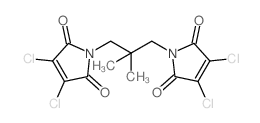203115-63-3
| Name | nsc 617145 |
|---|---|
| Synonyms |
3,4-dichloro-1-[3-(3,4-dichloro-2,5-dioxopyrrol-1-yl)-2,2-dimethylpropyl]pyrrole-2,5-dione
1,1'-(2,2-dimethyl-1,3-propanediyl)bis[3,4-dichloro-1H-Pyrrole-2,5-dione SID 487795 |
| Description | NSC 617145 is a selective werner syndrome helicase (WRN) helicase inhibitor with an IC50 value of 230 nM. NSC 617145 inhibits WRN ATPase, and induces double-strand breaks (DSB) and chromosomal abnormalities. NSC 617145 shows selective for WRN over BLM, FANCJ, ChlR1, RecQ, and UvrD helicases[1]. |
|---|---|
| Related Catalog | |
| In Vitro | NSC 617145 (0.75-3 μM; 24-72 hours) shows maximal inhibition of proliferation (98%) at the lowest concentration in a WRN-specific manner in HeLa cells[1]. NSC 617145 (0.75 μM; 6 hours) induces WRN binding to chromatin and proteasomal degradation[1]. In FA-D2-/- cells, NSC 617145 (0.125 μM) acts synergistically with very low concentrations of Mitomycin C to inhibit proliferation in a WRN-dependent manner and induce double-strand breaks (DSB) and chromosomal abnormalities. NSC 617145 exposure results in enhanced accumulation of DNA-PKcs pS2056 foci and Rad51 foci in Mitomycin C-treated FA-deficient cells, suggesting that WRN helicase inhibition prevents processing of Rad51-mediated recombination products and activates NHEJ[1]. NSC 617145, induces cell cycle arrest and apoptosis in human T-cell leukemia virus type 1 (HTLV-1)-transformed adult T-cell leukemia cells[2]. Cell Viability Assay[1] Cell Line: HeLa cells Concentration: 0.75 μM, 1 μM, 1.5 μM, 2 μM, 3 μM Incubation Time: 24 hours, 48 hours, 72 hours Result: Inhibited cell proliferation in a WRN-specific manner. Western Blot Analysis[1] Cell Line: HeLa cells Concentration: 0.75 μM Incubation Time: 6 hours Result: Caused WRN to become degraded by a proteasome-mediated pathway. |
| References |
| Molecular Formula | C13H10Cl4N2O4 |
|---|---|
| Molecular Weight | 400.04 |
| Exact Mass | 397.93900 |
| PSA | 74.76000 |
| LogP | 2.00440 |
| Symbol |

GHS07 |
|---|---|
| Signal Word | Warning |
| Hazard Statements | H315-H319-H335 |
| Precautionary Statements | P261-P305 + P351 + P338 |
| RIDADR | NONH for all modes of transport |
